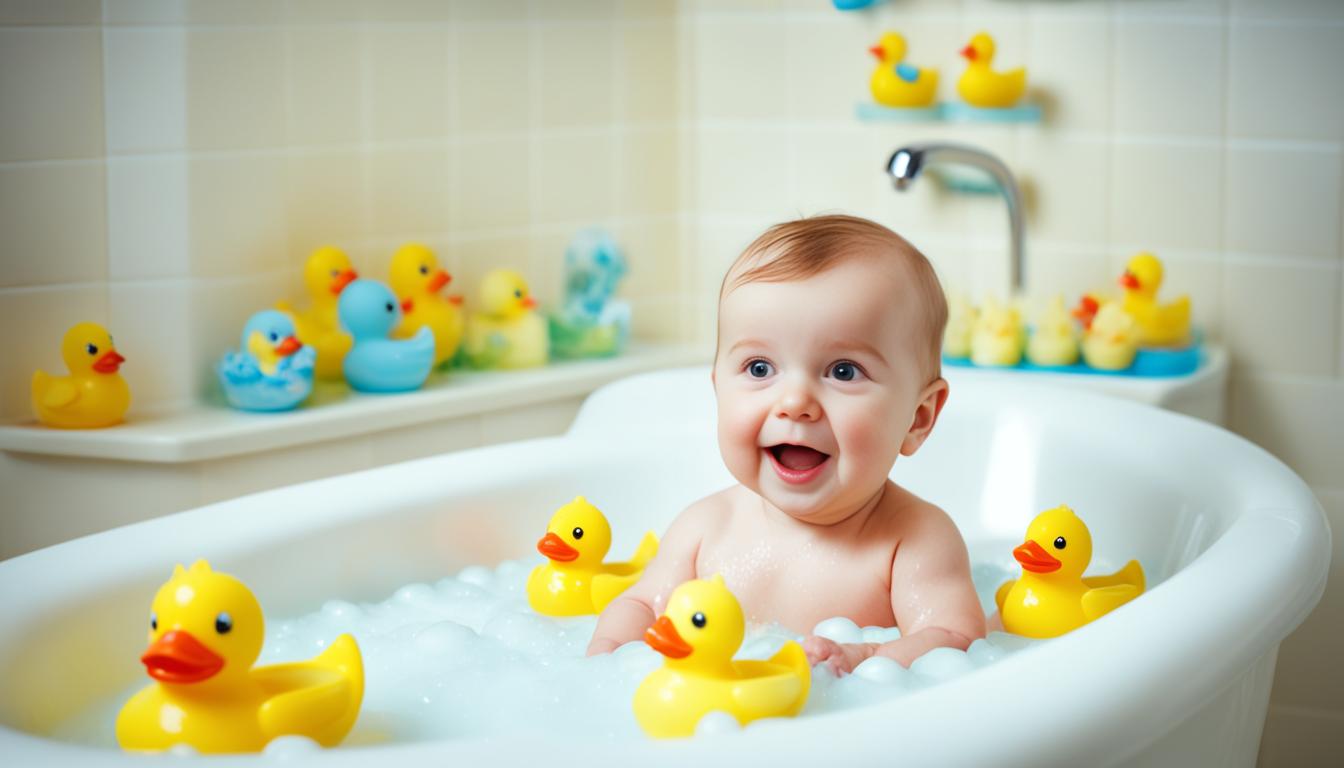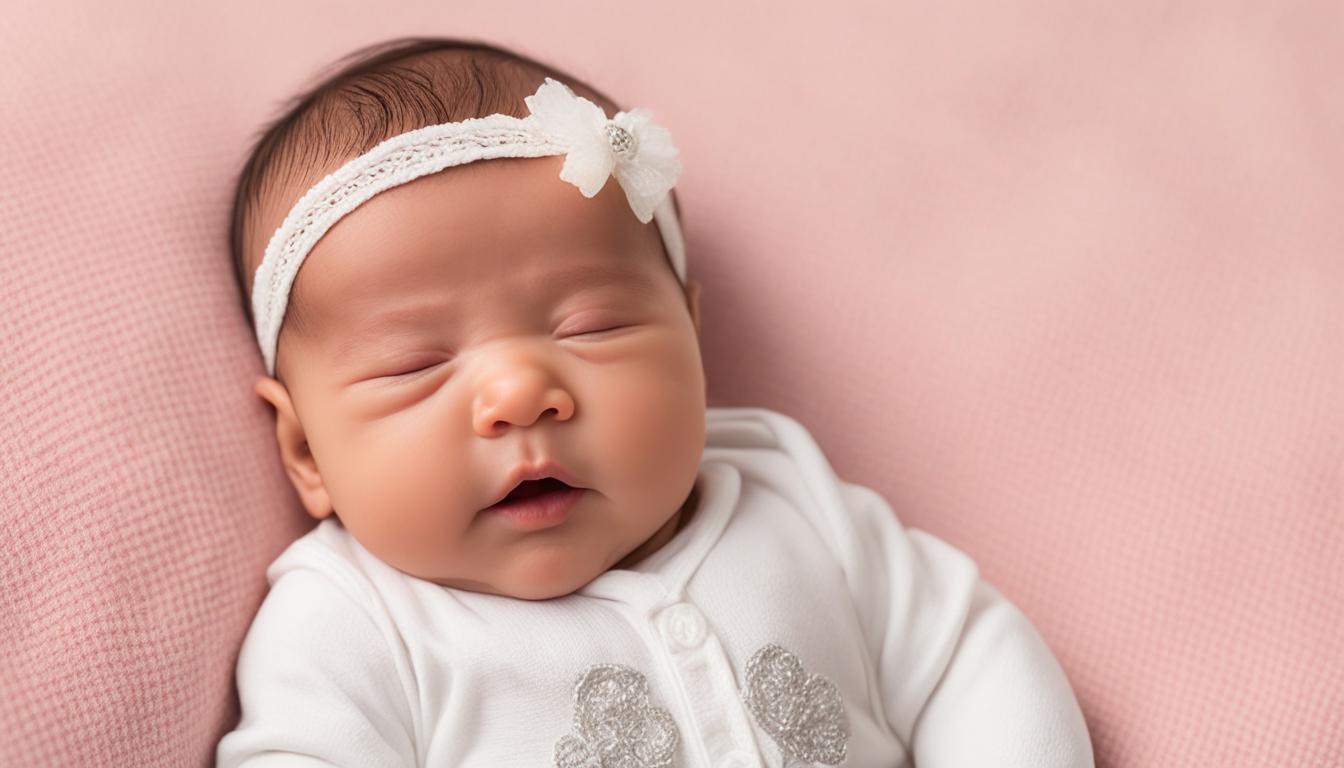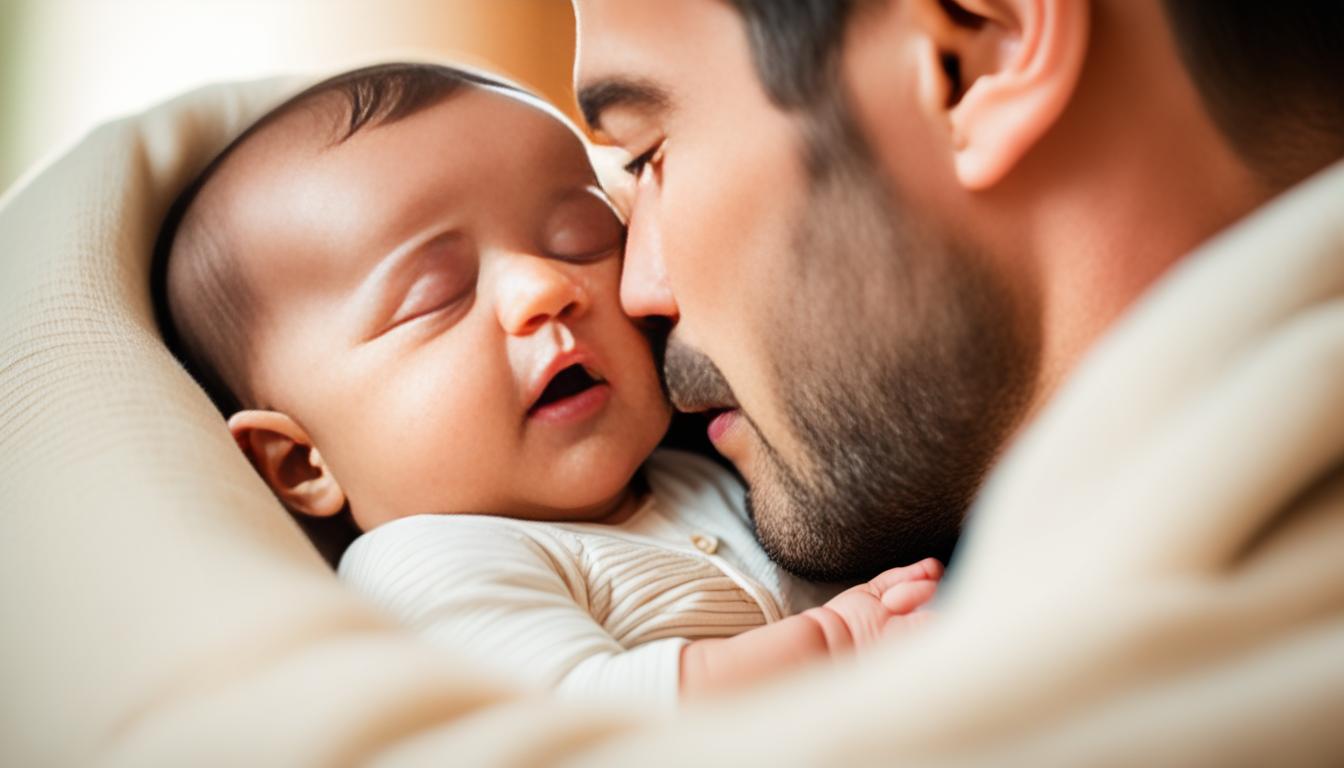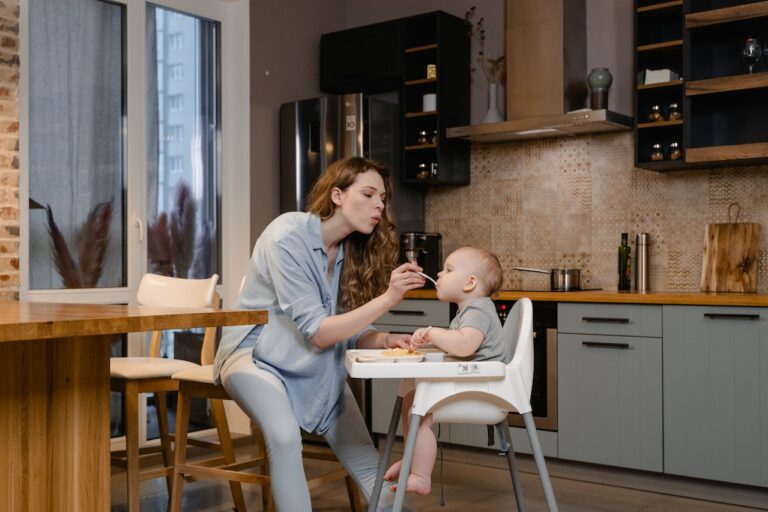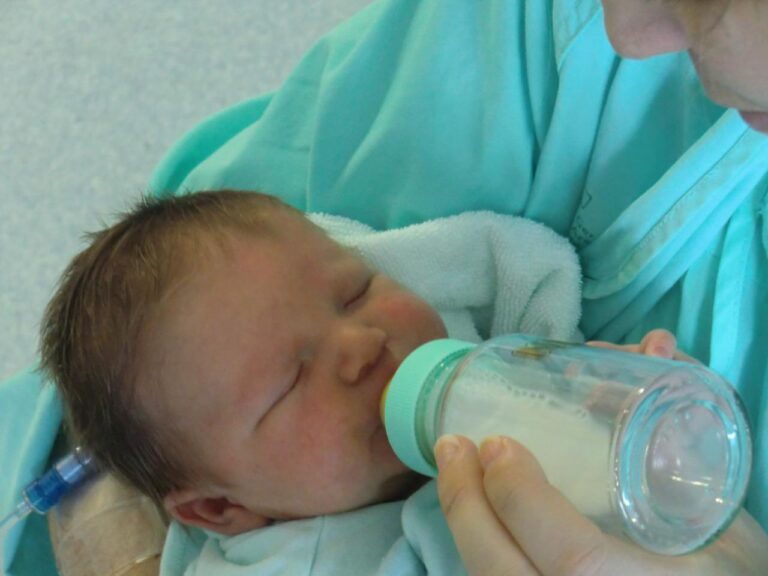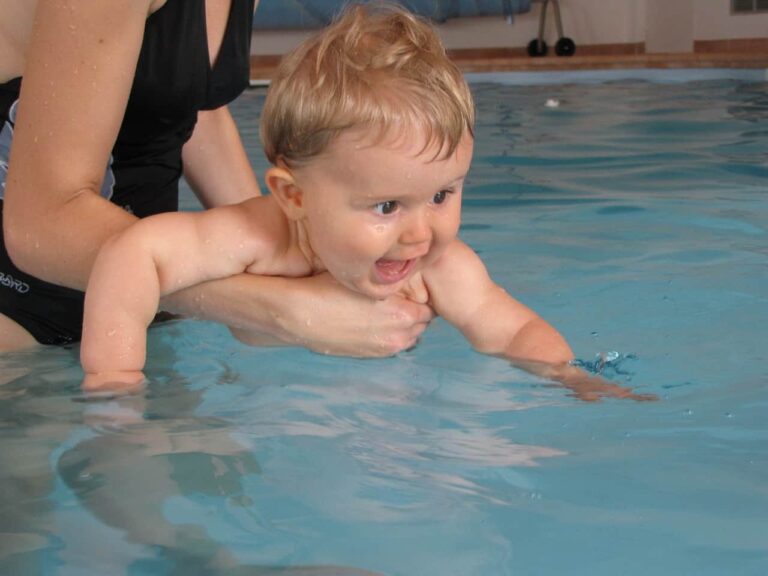How Often to Bathe Baby: Bathing Your Infant
As a new parent, you want to give your baby the best care possible. And when it comes to bathing, you may find yourself wondering how often you should bathe your little one. Should it be a daily routine or just a few times a week? There are varying opinions and advice out there, but what is the right answer?
In this article, I will debunk common myths and guide you through the recommended bathing schedule for infants. We’ll explore expert advice and research from reputable sources to help you make informed decisions about your baby’s hygiene needs.
Skip To The Following Sections
- When to Give Your Newborn Their First Bath
- Bathing Frequency for Newborns
- Bathing Tips for Newborns
- Transitioning to Regular Baths
- Bathing Tips for Older Babies
- Bathing Special Circumstances
- Baby Bathing Dos and Don’ts
- Bathing Your Baby: Tips for Success
- Bathing as Your Baby Grows
- Final Thoughts on Bathing Your Baby
- FAQ
- When should I give my newborn their first bath?
- How often should I bathe my newborn?
- What is the best way to bathe a newborn?
- How do I transition to regular baths for my baby?
- How often should I bathe my older baby?
- How should I clean special areas like the genital area?
- What are some bathing dos and don’ts for babies?
- How can I make bath time a positive experience for my baby?
- How should I adjust bathing as my baby grows?
- What are some final thoughts on bathing your baby?
Key Takeaways:
- Understanding the recommended bathing frequency for newborns is crucial to maintaining their comfort and cleanliness.
- Delaying the first bath for at least 24 hours after birth promotes bonding, breastfeeding, and healthy skin.
- Newborns typically only need to be bathed around three times a week to avoid drying out their delicate skin.
- Follow bathing tips for different stages, such as sponge baths for newborns and transitioning to regular baths as they grow.
- Always prioritize your baby’s safety and use gentle products that are suitable for their sensitive skin.
When to Give Your Newborn Their First Bath
According to the World Health Organization (WHO), the timing of a newborn baby’s first bath is an important consideration for their well-being. It is now recommended to delay the newborn’s first bath until 24 hours after birth, or at least 6 hours if a full day is not possible for cultural reasons[1]. This delay is based on research that highlights several benefits:
- Hypothermia prevention: Delaying the first bath helps to maintain the newborn’s body temperature, reducing the risk of hypothermia[2].
- Bonding and breastfeeding promotion: Immediate skin-to-skin contact after birth encourages bonding between the baby and parents. Delaying the first bath allows for more time spent together, which can enhance the emotional connection and support successful breastfeeding[3].
- Maintaining delicate skin moisture: The vernix caseosa, a white substance that covers the newborn’s skin, acts as a protective barrier and helps to retain moisture. Delaying the first bath allows the vernix caseosa to be absorbed, promoting skin hydration and reducing the risk of dryness[4].
It is important to note that the recommendation may vary in specific medical situations, such as when the mother has HIV or Hepatitis viruses. In these cases, early bathing is still necessary to reduce the risk of transmission of these infections[5].
Delaying the newborn’s first bath allows for a gentle and gradual transition into the world, focusing on their comfort, health, and bonding with their parents. It is an important consideration for promoting the well-being of both the baby and the family as a whole.
“Delaying the newborn’s first bath allows for more time spent together, enhancing the emotional connection and supporting successful breastfeeding.”
[1]
WHO Guideline: Delayed Umbilical Cord Clamping for Improved Maternal and Infant Health and Nutrition Outcomes
[2]
NHS Inform: Keeping Your Baby Comfortable
[3]
American Academy of Pediatrics: Breastfeeding and the Use of Human Milk
[4]
Journal of Obstetric, Gynecologic, and Neonatal Nursing: Vernix Caseosa: An Underexplored Mixture of Lipids Suspected to Help Human Newborns Adapt to Extrauterine Life
[5]
HealthyChildren.org: Newborn Bathing
Bathing Frequency for Newborns
When it comes to bathing newborns, many parents wonder how often they should do it. It’s important to find the right balance between cleanliness and preserving their delicate skin. Here’s what experts recommend:
- Give your baby a bath around three times a week during their first year. This frequency is sufficient to keep them clean without drying out their sensitive skin.
- Over-bathing can strip the natural oils from their skin, leading to dryness and irritation. By following a bathing routine of three times a week, you can maintain their skin’s natural moisture balance.
- Remember, every baby is unique, so the ideal bathing frequency might vary. Observe your little one’s skin and adjust accordingly if you notice any signs of dryness or irritation.
Bathing your newborn is not just about cleanliness but also an opportunity for nurturing bonds and relaxation. Enjoy these special moments with your baby while maintaining their comfort and well-being.
Bathing Tips for Newborns
When it comes to bathing your newborn, their safety and hygiene are of utmost importance. Before the umbilical cord falls off, it is recommended to give them sponge baths instead of fully immersing them in water. This ensures that the delicate area around the cord remains clean and dry for faster healing.
To give your baby a sponge bath, follow these simple steps:
- Prepare a warm, quiet, and well-lit area for the bath. Make sure you have all the necessary supplies within reach.
- Undress your baby, leaving only their diaper on.
- Place a soft washcloth or sponge into a basin of warm water. Gently squeeze out the excess water.
- Starting from their face, use the damp washcloth to clean their eyes, ears, and nose. Be extra careful around their delicate skin.
- Move on to the rest of their body, paying special attention to the creases and folds where dirt and moisture can accumulate. Use gentle, circular motions.
- Remember to clean their diaper area thoroughly, but always be gentle and avoid any harsh rubbing.
- Dry your baby carefully with a soft towel, making sure to keep them warm throughout the bath. Cover parts of their body with the towel and only expose the areas you are actively cleaning.
- Finally, once the bath is complete, put a fresh diaper on your baby and dress them in clean clothes.
During the sponge bath, it is crucial to ensure your baby’s safety at all times. Keep a hand on your baby to prevent falls and accidents. Remember, they are still very fragile and require constant supervision.
Quote: “A sponge bath is a gentle way to cleanse your newborn without exposing them to excessive water. It helps maintain their hygiene while protecting the healing umbilical cord area.” – Dr. Emily Thompson, Pediatrician
By following these bathing tips, you can keep your newborn clean and maintain their hygiene while promoting a safe and soothing bath experience for your little one.
| Sponge Bath Benefits | Sponge Bath Precautions |
|---|---|
|
|
Remember, bathing your newborn is not only about cleanliness but also about creating bonding moments and providing comfort. Enjoy this special time with your little one while prioritizing their safety and well-being.
Transitioning to Regular Baths
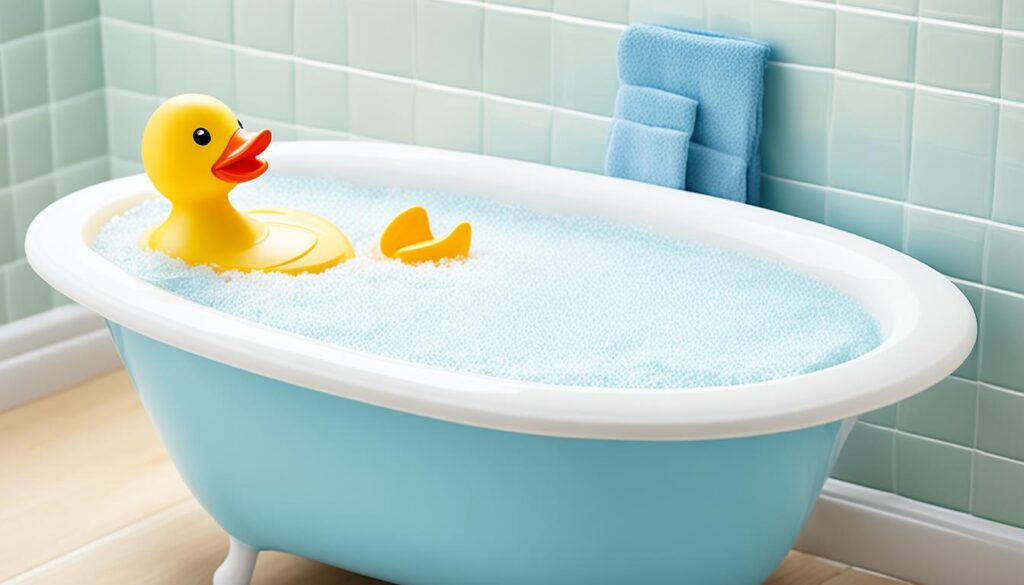
Now that your baby’s umbilical area has healed, it’s time to transition to regular baths. This is an exciting milestone in your baby’s hygiene routine. Here are some tips to ensure a safe and enjoyable bathing experience for your little one.
Choosing a Baby Bathtub or Sink Bathing
When it comes to bathing your baby, you have options. You can use a baby bathtub or opt for sink bathing. Both options have their benefits, so choose what works best for you and your baby.
If you decide to use a baby bathtub, make sure it is safe and secure. Look for one with a non-slip bottom and a comfortable incline for your baby to lie back on. Keep in mind that baby bathtubs come in different sizes, so choose one that suits your baby’s age and size.
If you prefer sink bathing, line the sink with a clean towel to provide a soft and cozy surface for your baby. Just make sure the sink is clean and free from any sharp edges.
Bath Safety Precautions
When giving your baby a regular bath, safety is paramount. Follow these bath safety guidelines to prevent accidents and ensure your baby’s well-being:
- Always keep a hand on your baby during the entire bath. Babies can slip or turn unexpectedly, so it’s crucial to have a firm hold on them at all times.
- Never leave your baby unattended in the bath, even for a moment. If you need to step away, wrap your baby in a towel and take them with you.
- Ensure the water depth is minimal, usually just a few inches. This will make it easier to support your baby and prevent them from accidentally submerging their face.
- Check the water temperature before placing your baby in the bath. It should be warm but not hot, around 100°F (37°C). Use your elbow or a thermometer to test the water.
- Keep bath supplies within reach, including soap, shampoo, and a soft washcloth. This way, you won’t have to leave your baby unattended to fetch them.
Following these precautions will help create a safe and secure bathing environment for your little one.
Safe Bathing Guidelines
| Bath Safety Guidelines | Details |
|---|---|
| Always supervise your baby | Keep a hand on your baby at all times during the bath. |
| Never leave your baby unattended | Even for a moment, always take your baby with you if you need to step away. |
| Ensure minimal water depth | Aim for just a few inches of water to prevent accidental submersion. |
| Check water temperature | Test the water with your elbow or a thermometer to ensure it’s warm but not hot. |
| Keep bath supplies within reach | Prepare all necessary bathing supplies ahead of time to avoid leaving your baby’s side. |
By following these safe bathing guidelines, you can ensure that your baby’s regular baths are both enjoyable and secure.
Bathing Tips for Older Babies
As your baby grows, their bathing routine may need to be adjusted to accommodate their changing needs and preferences. Here are some helpful tips for bathing older babies:
1. Frequency
Continue bathing your baby around three times a week, unless they get excessively dirty or sweaty. This frequency will help maintain their cleanliness without drying out their delicate skin.
2. Soap Selection
Choose mild, neutral-pH soaps without any harsh additives. These gentle cleansers will help keep your baby’s skin moisturized and avoid any potential irritations.
3. Hair Washing
Wash your baby’s hair two or three times a week, using a gentle baby shampoo or body wash. Gently massage their scalp to remove any dirt or oil buildup.
4. Introduce Bath Toys
Make bath time fun and interactive by introducing bath toys. These toys can engage your baby’s senses and make the bathing experience more enjoyable.
5. Creating a Relaxing Environment
Ensure the bath area is warm and comfortable for your baby. Maintain a consistent room temperature throughout the bath and have all the necessary bath essentials within reach.
“Bath time can be a great opportunity for bonding and relaxation. Use this time to engage with your baby, singing songs or talking to them while gently washing their little body. It’s not just about cleanliness, but also about creating a positive experience and building a stronger connection.”
| Tips for Bathing Older Babies |
|---|
| Continue bathing around three times a week |
| Use mild, neutral-pH soaps |
| Wash hair two or three times a week |
| Introduce bath toys for interactive play |
| Create a warm and comfortable environment |
With these bathing tips, you can ensure that your older baby enjoys a clean and pleasant bath routine while maintaining their delicate skin’s health and overall well-being.
Bathing Special Circumstances
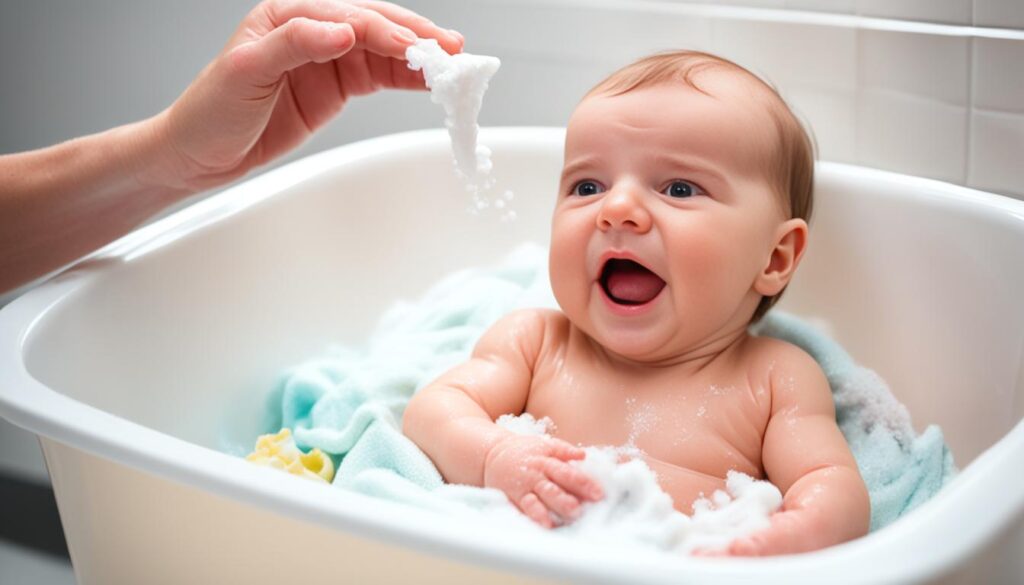
When it comes to bathing your newborn, there are certain special circumstances that require extra attention and care. From umbilical cord care to addressing common skin conditions, here are some important considerations:
1. Genital Area Cleaning
When cleaning the genital area, it’s crucial to ensure thorough hygiene to prevent any infections. For female babies, wipe gently from front to back to avoid transferring bacteria from the anus to the urinary tract. This practice helps reduce the risk of urinary tract infections.
2. Care for Circumcised or Uncircumcised Penis
If your baby has a circumcised or uncircumcised penis, it’s important to follow specific cleaning instructions. For circumcised babies, gently clean the area with warm water and mild soap, being careful not to disrupt the healing process. For uncircumcised babies, avoid pulling back the foreskin; simply clean the outside of the area with warm water.
3. Handling Skin Conditions
Many babies experience common skin conditions like cradle cap and diaper dermatitis. To address these conditions, use appropriate products and techniques for gentle cleansing. Consult with your pediatrician for suitable remedies or treatments to alleviate discomfort and promote healing.
4. Diaper Changes and Stool Cleaning
Regularly changing your baby’s diapers and ensuring thorough cleaning after a bowel movement is essential to prevent skin irritation. Use gentle wipes or warm water and a clean cloth to wipe the diaper area. Be sure to wipe from front to back for both boys and girls to reduce the risk of infection.
By paying special attention to these bathing circumstances, you can ensure your baby’s comfort, hygiene, and overall well-being.
Baby Bathing Dos and Don’ts
When it comes to bathing your newborn, ensuring their safety is of utmost importance. Here are some essential dos and don’ts to keep in mind:
Do:
- Always maintain touch supervision while bathing your baby to prevent accidents.
- Keep a hand on your baby at all times to ensure they are secure and supported.
- Ensure the water temperature is warm but not hot. Use a bath thermometer to check the temperature before placing your baby in the water.
- Use appropriate bathing equipment, such as a safe infant tub or a sink with a clean towel lining, to provide a comfortable and secure bathing space.
Don’t:
- Never leave your baby unattended in the bath, even for a moment.
- Avoid using bath seats as they can tip over and pose a drowning hazard.
- Avoid using excessively hot water, as it can scald your baby’s delicate skin.
Remember, bath time should be a safe and enjoyable experience for both you and your baby. By following these dos and don’ts, you can create a nurturing environment that promotes bonding and cleanliness without compromising on safety.
| Bathing Dos | Bathing Don’ts |
|---|---|
| Always maintain touch supervision | Never leave your baby unattended |
| Keep a hand on your baby at all times | Avoid using bath seats |
| Ensure water temperature is warm but not hot | Avoid excessively hot water |
| Use appropriate bathing equipment |
Bathing Your Baby: Tips for Success
Making bath time a positive and enjoyable experience for your baby is important. Here are some tips to ensure a successful and pleasant bathing routine:
- Create a Routine: Establish a consistent bath time routine that works for you and your baby. Whether you incorporate it into their bedtime routine or use it as a bonding opportunity during the day, having a predictable schedule can help your baby feel secure and relaxed.
- Use Mild and Gentle Products: Choose baby skincare products that are specifically formulated for their delicate skin. Look for products that are hypoallergenic, fragrance-free, and gentle on the skin. Avoid harsh soaps or cleansers that can strip away natural oils and cause dryness or irritation.
- Provide Appropriate Support: Use a baby bathtub or a basin lined with a towel to provide support for your baby’s head and body during the bath. Ensure that they are comfortable and secure, and always keep a hand on your baby to prevent any slips or accidents.
- Maintain a Comfortable Room Temperature: Before starting the bath, ensure that the room is comfortably warm. Babies lose heat more quickly than adults, so make sure the room is free from drafts and warm enough to keep them comfortable during the bathing process.
Remember, every baby is unique, and what works for one may not work for another. Pay attention to your baby’s cues and preferences, and adjust your bathing routine accordingly. Bath time should be a soothing and nurturing experience for both you and your little one.
Bathing as Your Baby Grows
As your baby grows, their bathing needs may change. It’s important to adjust the bathing schedule to accommodate their evolving activity level, exposure to dirt and sweat, and personal preferences. By doing so, you can ensure that your baby stays clean and comfortable, promoting their overall hygiene and well-being.
Incorporating bath time into their routine can be beneficial. Establishing a consistent bathing schedule helps your baby anticipate and prepare for their bath, creating a sense of familiarity and comfort. Consider making bath time a relaxing and enjoyable experience by playing soft music or introducing bath toys to keep them engaged.
To maintain your baby’s skin health, continue using gentle products specifically formulated for infants. Look for mild, hypoallergenic cleansers and moisturizers that are free of harsh chemicals and fragrances. These products help preserve the natural moisture and balance of your baby’s delicate skin, preventing dryness and irritation.
It’s worth noting that every baby is unique, and their bathing needs may vary. Some babies may enjoy daily baths, while others may benefit from bathing every other day or a few times a week. Observing your baby’s cues and skin condition can guide you in determining the frequency of baths that suits them best.
Tips for Bathing Your Growing Baby:
- Use warm water for their bath, testing the temperature to ensure it’s comfortable.
- Gently wash their body and ensure to clean all the creases and folds, which tend to accumulate dirt and moisture.
- Pay special attention to cleaning their diaper area, using mild cleansers and gentle wipes.
- After the bath, carefully pat your baby’s skin dry with a soft towel, paying attention to areas that tend to retain moisture.
- Apply a gentle moisturizer to their skin to help maintain its hydration.
Remember, bathing your growing baby is not only essential for their hygiene but also provides precious bonding moments between you and your little one. Enjoy this special time and continue to prioritize their comfort and well-being throughout their bathing routine.
| Age | Bathing Frequency |
|---|---|
| Newborn to 1 month | 3 times a week |
| 1 to 6 months | 2 to 3 times a week |
| 6 to 12 months | 2 to 3 times a week |
Final Thoughts on Bathing Your Baby
Bathing your baby is not only a necessary part of their hygiene routine but also a special bonding experience. Following the recommended bathing schedule, adjusting it as your baby grows, and prioritizing their safety and comfort are essential.
When it comes to caring for your baby’s delicate skin, gentle and mild products are key. Opt for skincare products specifically designed for infants to avoid any potential irritations or allergies.
Additionally, keep in mind that every baby is unique, so understanding your little one’s specific needs and preferences is crucial. Experiment with different bathing techniques and routines until you find what works best for both you and your baby. Remember to maintain a comfortable room temperature during the bath to keep your baby’s body warm and prevent chills.
By approaching bath time with patience, love, and proper care, you can transform a simple hygiene task into a delightful and beneficial experience for your precious little one.
FAQ
When should I give my newborn their first bath?
It is recommended to delay the first bath until 24 hours after birth, or at least 6 hours if a full day is not possible. This helps prevent hypothermia, promotes bonding and breastfeeding, and maintains your baby’s delicate skin’s moisture.
How often should I bathe my newborn?
Newborns do not need to be bathed every day. Experts recommend giving them a bath around three times a week during their first year. Each baby is unique, so the bathing frequency may vary based on individual needs.
What is the best way to bathe a newborn?
Before the umbilical cord falls off, it is best to give your newborn sponge baths instead of fully immersing them in water. Use a soft washcloth dipped in warm water to gently clean their face, body, and diaper area. Pay special attention to the creases and folds of their skin.
How do I transition to regular baths for my baby?
Once the umbilical area is healed, you can start giving your baby regular baths. Use a safe infant tub or a sink lined with a clean towel. Make sure the water depth is minimal, usually a few inches, and check the water temperature to ensure it is warm but not hot.
How often should I bathe my older baby?
As your baby grows, you can continue bathing them around three times a week. Adjust the frequency based on their activity level and personal preferences. Use mild, neutral-pH soaps without additives to avoid drying out their skin.
How should I clean special areas like the genital area?
When bathing your baby, take special care in cleaning areas such as the genital area, ensuring thorough cleaning and wiping from front to back for female babies. If your baby has a circumcised or uncircumcised penis, follow specific cleaning instructions to prevent infection.
What are some bathing dos and don’ts for babies?
Always maintain a safe environment when bathing your baby. Keep a hand on them at all times, ensure the water temperature is warm but not hot, and never leave them unattended. Avoid using bath seats as they can tip over and pose a drowning hazard.
How can I make bath time a positive experience for my baby?
Make bath time enjoyable by incorporating it into your baby’s routine and using mild and gentle products. Provide appropriate support for their head and body, and maintain a comfortable room temperature during the bath.
How should I adjust bathing as my baby grows?
As your baby grows, their bathing needs may change. Adjust the bathing schedule accordingly, ensuring that your baby stays clean and comfortable. Incorporate bath time into their routine and continue to use gentle products to maintain their skin health.
What are some final thoughts on bathing your baby?
Bathing your baby is a special time for bonding and ensuring their hygiene. Remember to follow the recommended bathing schedule, adjust it as your baby grows, and prioritize their safety and comfort during the bath. With proper techniques and care, you can make bath time an enjoyable and beneficial experience for your little one.

